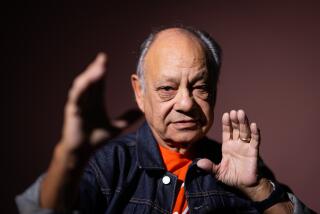Printmaker Richard Duardo made his art — and others’ — pop
- Share via
“An artist could have no better friend” than Richard Duardo, said comedian and actor Cheech Marin.
As a master printer, the Boyle Heights-born Duardo, who died last year, produced work for more than 450 artists throughout his career, including Keith Haring, David Hockney, Shepard Fairey and Banksy, and he made prints based on paintings in Marin’s personal collection. He was also a champion for lesser-known, emerging artists, particularly in the Chicano community — at his last printing workshop, Los Angeles’ Modern Multiples, he would regularly take young talents under his wing.
As an artist in his own right, Duardo was nearly as prolific. He created brightly colored, silk-screen portraits of arts and pop culture icons, including Bob Dylan, Jimi Hendrix, Che Guevara and Lauren Bacall, among many others. The boldly drawn works, saturated in tangerine, aqua and hot pink hues — many of them in series — earned him the nickname “The West Coast Warhol.”
ESSENTIAL ARTS & CULTURE NEWSLETTER >> Get great stories delivered to your inbox
A new exhibition at the McNay Art Museum in San Antonio, “Richard Duardo: Maestro of Pop,” showcases about 20 of Duardo’s large-scale screen prints, including portraits of Elvis Presley, Audrey Hepburn, Marilyn Monroe and Warhol himself. The bold and poppy works are divided into artist, musician and actor-celebrity portraits — some of them are upward of 6 feet tall, such as his towering prints of Raquel Welch and Miley Cyrus.
“When he told me he was doing a portrait of Miley Cyrus, I said, ‘Why?!’ Because I hadn’t felt she’d reached the success of the others,” says Lyle Williams, who organized the McNay show. “But it was indicative of Richard’s personality — he always wanted to keep up with the latest and greatest in contemporary art and what young people were listening to.”
Originally, “Maestro of Pop” was intended to be a much smaller exhibition, but after Duardo’s death in November at 62, Williams expanded it.
“I thought it was important to make it a memorial,” Williams says. “Richard was a force in the art community in L.A. and in San Antonio when he was here. He spotted talent, especially talent that wasn’t wholly developed yet. And he worked with so many important contemporary artists — it was that printing background that separated him from Warhol, that technical ability. He was able to teach that to others and that was really his great contribution.”
More to Read
The biggest entertainment stories
Get our big stories about Hollywood, film, television, music, arts, culture and more right in your inbox as soon as they publish.
You may occasionally receive promotional content from the Los Angeles Times.











